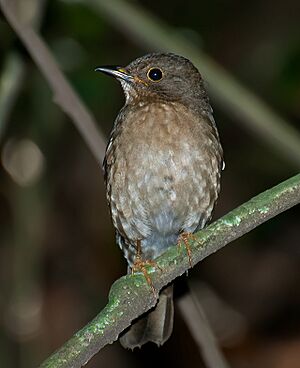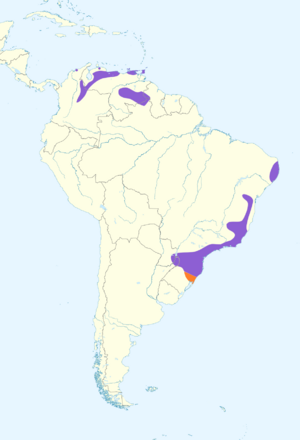Yellow-legged thrush facts for kids
Quick facts for kids Yellow-legged thrush |
|
|---|---|
 |
|
| Adult male in São Paulo, Brazil | |
 |
|
| Adult female in São Paulo, Brazil | |
| Conservation status | |
| Scientific classification | |
| Genus: |
Turdus
|
| Species: |
flavipes
|
 |
|
| Synonyms | |
|
Platycichla flavipes (Vieillot, 1818) (but see text) |
|
The yellow-legged thrush (Turdus flavipes) is a type of songbird. You can find it in northern and eastern South America and the Caribbean.
Contents
About the Yellow-Legged Thrush
What Does It Look Like?
This thrush is about 22 to 23 centimeters (8.7 to 9.1 inches) long. It weighs between 55 and 70 grams (1.9 to 2.5 ounces). Both male and female birds have bright yellow legs and a yellow ring around their eyes.
The male bird has a yellow beak. Its body is usually black with a gray back and lower belly. However, the gray color can change. One type of yellow-legged thrush, found in Tobago, is completely black. It looks a lot like the male Eurasian blackbird.
Female yellow-legged thrushes have a duller beak. Their upper body is warm brown, and their belly is lighter. Young male birds are brownish with black wings and tail. Young female birds look like the adults but are duller. They have orange spots on top and dark brown spots and bars underneath.
What Does It Sound Like?
The male yellow-legged thrush sings beautiful, musical songs. It often sounds like "sreep, sreee, sree, sreee." This song is a bit like the Eurasian blackbird's song. Sometimes, it even copies sounds from other birds. When the bird is worried, it makes a sharp "srip" sound or a special "seeet" call.
Where Yellow-Legged Thrushes Live
Their Homes and Habitats
Yellow-legged thrushes live in different areas that are far apart. One group lives in northern Colombia, Venezuela, and northern Brazil. They also live on islands like Trinidad, Tobago, and Margarita Island. You can also find them in parts of Guyana.
Another group lives in eastern Brazil, eastern Paraguay, and northeastern Argentina. The birds in Argentina sometimes move to different places. Those in the far south travel north for the winter. Some birds in northern South America also move around locally.
Where They Prefer to Live
These small thrushes like to live in rainforests. They also live in forests that have grown back after being cut down. Sometimes, they live in old plantations. They mostly live in highlands up to 2,000 meters (6,600 feet) above sea level. But in some places, they can be found closer to the sea level.
Yellow-Legged Thrush Life
What Do They Eat?
The yellow-legged thrush mostly finds its food in trees and bushes. It rarely looks for food on the ground. They mainly eat fruits and berries. For example, they like fruits from plants like Melastomataceae. They usually stay high in the trees. Because of this, they rarely join groups of different bird species looking for food together.
Nests and Eggs
The nest of a yellow-legged thrush is like a shallow cup. It is made of twigs and lined with soft material. They build their nests on a bank or among rocks. The female bird lays two or three eggs. These eggs are green or blue with reddish spots.
Conservation Status
The yellow-legged thrush is quite common in most places where it lives. Because of this, the IUCN lists it as a species of "Least Concern". This means it is not currently in danger of disappearing. However, this bird is shy. The female bird, especially, is hard to see. She does not sing, and her colors help her blend in with her surroundings.
Images for kids



